Step into the heart of the home and imagine a kitchen that instantly feels grounded, inviting, and timeless. Brown kitchen cabinets offer this rare combination of qualities that continues to make them a favorite choice for homeowners seeking both beauty and practicality. Far from being old-fashioned, these cabinets provide a rich canvas for design, anchoring styles from rustic farmhouse to sleek contemporary with equal grace.
The inherent warmth of brown creates a psychological comfort that’s difficult to achieve with cooler tones. This natural richness adds depth and character, making the kitchen feel more lived-in and personal rather than sterile or purely functional. Brown cabinets also represent a substantial investment that suggests quality and attention to detail, with their timeless nature ensuring your kitchen remains relevant and appealing for years to come.
“Brown is the color of earth, wood, and stone. It’s a color that speaks of reliability and support—exactly what we want from the heart of our homes.” — Interior design principle
The magic of this palette begins with understanding the remarkable spectrum of browns available, from the deepest espresso to the lightest honey tones, each creating a distinctly different mood and style. Join us as we explore why brown cabinets are not just a choice, but a foundation for a kitchen that truly feels like home.
1. Discovering the Warmth: Why Brown Kitchen Cabinets Are a Top Choice
Step into the heart of the home and imagine a kitchen that instantly feels grounded, inviting, and timeless. Brown kitchen cabinets offer this rare combination of qualities that continues to make them a favorite choice for homeowners seeking both beauty and practicality. Far from being old-fashioned, these cabinets provide a rich canvas for design, anchoring styles from rustic farmhouse to sleek contemporary with equal grace.
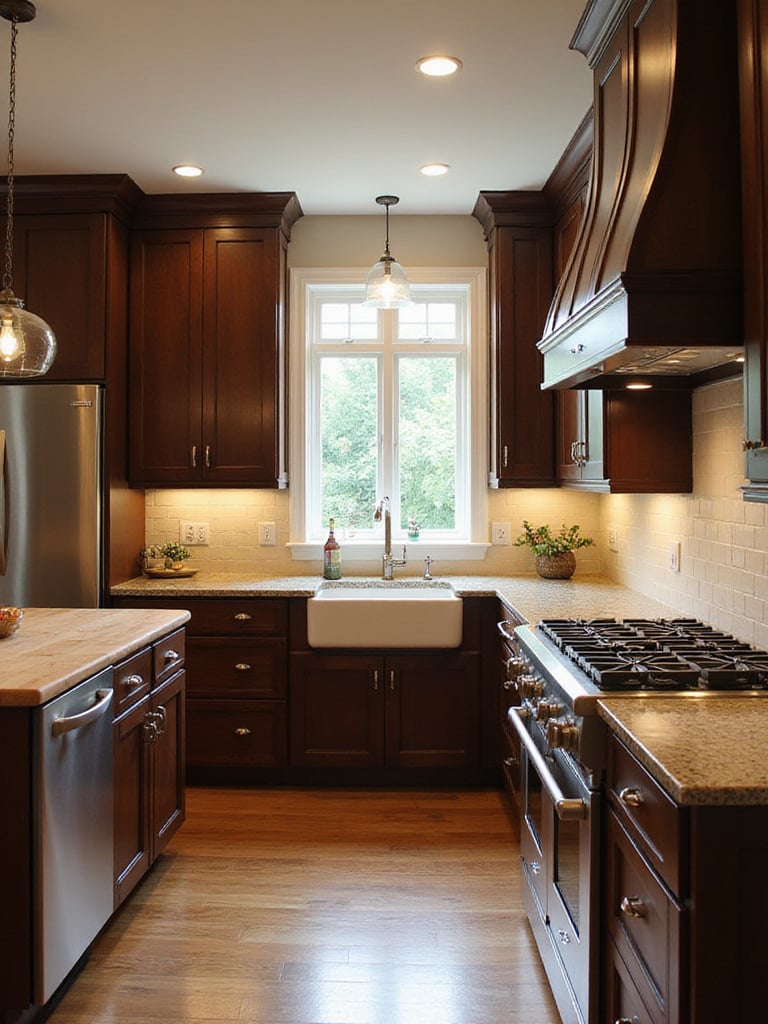
The inherent warmth of brown creates a psychological comfort that’s difficult to achieve with cooler tones. This natural richness adds depth and character, making the kitchen feel more lived-in and personal rather than sterile or purely functional. Brown cabinets also represent a substantial investment that suggests quality and attention to detail, with their timeless nature ensuring your kitchen remains relevant and appealing for years to come.
“Brown is the color of earth, wood, and stone. It’s a color that speaks of reliability and support—exactly what we want from the heart of our homes.” — Interior design principle
The magic of this palette begins with understanding the remarkable spectrum of browns available, from the deepest espresso to the lightest honey tones, each creating a distinctly different mood and style.
2. From Espresso to Honey: Navigating the Many Shades of Brown
The inspiration for this collection of brown tones strikes when you realize just how vast the spectrum truly is. Espresso cabinets offer a sophisticated, almost black depth that creates dramatic contrast. Dark chocolate provides luxurious richness without the severity of espresso. Walnut presents that classic medium-dark elegance with distinctive grain patterns, while mahogany introduces subtle reddish undertones that warm any space. Medium browns strike a versatile balance, and lighter options like honey oak showcase the natural beauty of wood grain while brightening the room.
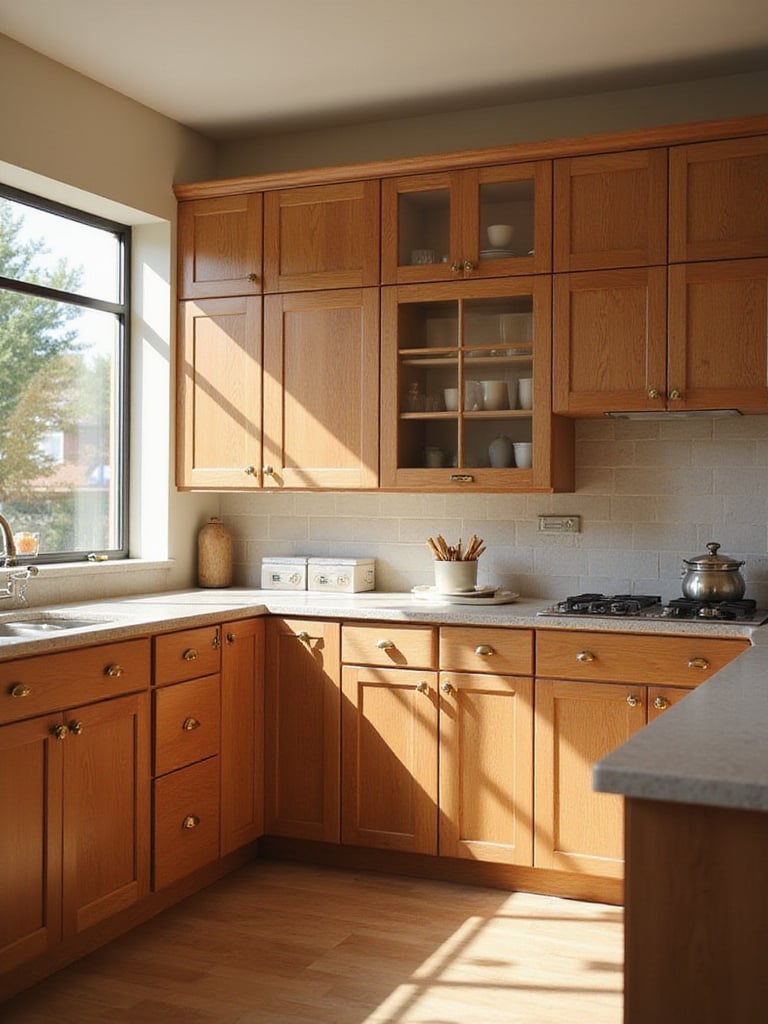
The specific shade you select fundamentally shapes your kitchen’s personality. Darker browns create formality and sophistication, pairing beautifully with contemporary designs. Medium browns adapt effortlessly to transitional or traditional styles. Lighter browns and honey tones naturally evoke a relaxed, inviting atmosphere perfect for farmhouse or cottage aesthetics. Always consider the undertones—warm (reddish, golden) browns foster coziness, while cool (grayish) undertones contribute to a more modern feel.
- Consider the natural light in your kitchen—darker browns need more illumination
- Test samples under both daytime and evening lighting conditions
- Remember that cabinet color affects perceived room size—lighter browns can make smaller kitchens feel larger
Unlike mass-produced alternatives, the natural variations in wood brown cabinets create a kitchen with character that tells a unique story through its grain patterns and subtle color shifts.
3. The Enduring Appeal of Natural Wood Brown Cabinets
The artisans behind these designs began with a profound respect for wood’s natural beauty. What makes natural wood brown cabinets special is their inherent uniqueness—no two pieces are identical, with each cabinet door and drawer front presenting its own distinctive grain pattern and color variations. This organic quality creates a kitchen that feels authentic and connected to nature in a way that manufactured materials simply cannot replicate. The warmth of real wood resonates on both visual and tactile levels, inviting touch and creating an atmosphere of comfort that transcends passing trends.
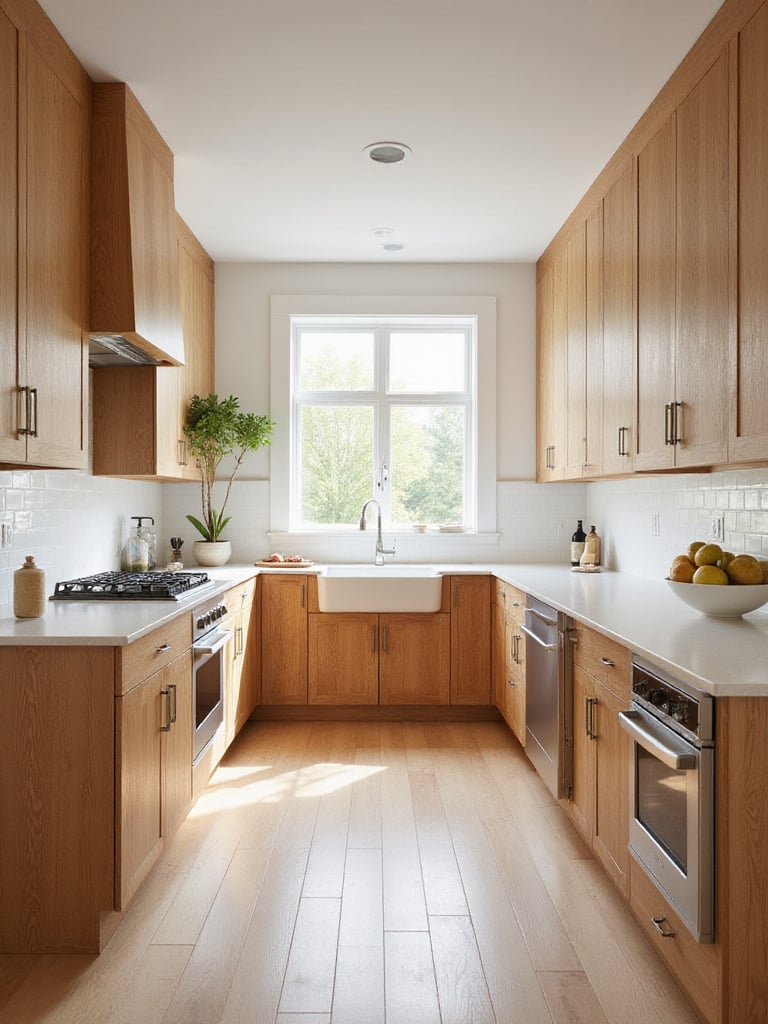
The variety within natural wood brown cabinets is remarkable, with different species offering distinct personalities. Oak delivers prominent grain with traditional character, while cherry develops a rich patina that deepens beautifully over time. Walnut provides chocolate-like depth with sophisticated grain patterns, and maple offers a smoother, more uniform canvas that takes stains consistently. Pine brings casual warmth with its distinctive knots and casual character, while exotic woods like teak or mahogany offer unique grain patterns and natural color variations that become the kitchen’s focal point.
- Natural wood cabinets develop character over time, unlike synthetic materials
- Different wood species vary dramatically in hardness and durability
- The natural oils in some woods (like walnut) create built-in resistance to moisture
Running your hand across this material reveals the subtle texture variations that synthetic alternatives can never truly duplicate, but modern finishes have expanded the possibilities beyond natural wood.
4. Beyond Wood: Modern Painted & Stained Brown Finishes
What makes this design special is the way modern finishes have transformed the possibilities for brown kitchen cabinets. Today’s painted and stained finishes offer remarkable advantages beyond the natural wood look, including greater color consistency, enhanced durability, and often more budget-friendly options. High-quality painted brown finishes can be applied to materials like MDF or poplar, creating a smooth, uniform appearance with precise color control. Modern stains penetrate the wood while allowing its natural grain to show through, offering the best of both worlds—controlled color with organic texture.
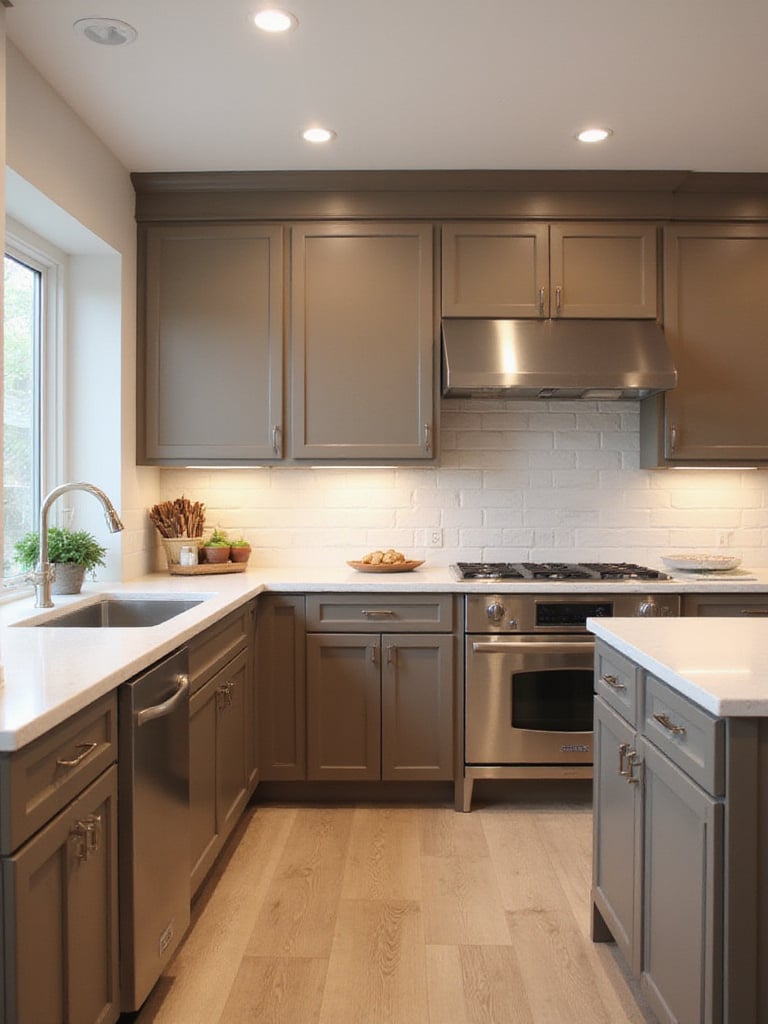
The unexpected environmental benefit comes from how these finishes can transform sustainable woods or engineered materials into stunning kitchens. Trending brown finishes include sophisticated cool browns like taupe and greige that bring contemporary flair, warm mochas and chestnuts that radiate comfort, and two-tone approaches using different brown shades on upper and lower cabinets. These modern finishes typically include protective topcoats that resist moisture, scratches, and UV damage better than many traditional finishes, making them practical choices for busy kitchens.
“The modern brown kitchen is about intention rather than default—choosing brown as a deliberate design statement rather than simply accepting the wood tone that comes standard.” — Contemporary design philosophy
The craftsmanship reveals itself in details like how these finishes interact with light throughout the day, creating subtle shifts in appearance from morning to evening that bring the kitchen to life.
5. Countertop Pairings That Shine with Brown Cabinets
The visual weight balances perfectly when you pair brown kitchen cabinets with the right countertop material and color. This critical design decision either enhances or diminishes the overall impact of your cabinets. Light countertops create striking contrast that allows rich brown cabinetry to stand as the kitchen’s anchor, while letting the space feel open and bright. Materials like white quartz, marble with delicate veining, or light granite create this beautiful juxtaposition. For a more dramatic statement, darker countertops in charcoal, black, or deep green can create a sophisticated, cocooning effect, though this approach requires thoughtful lighting.
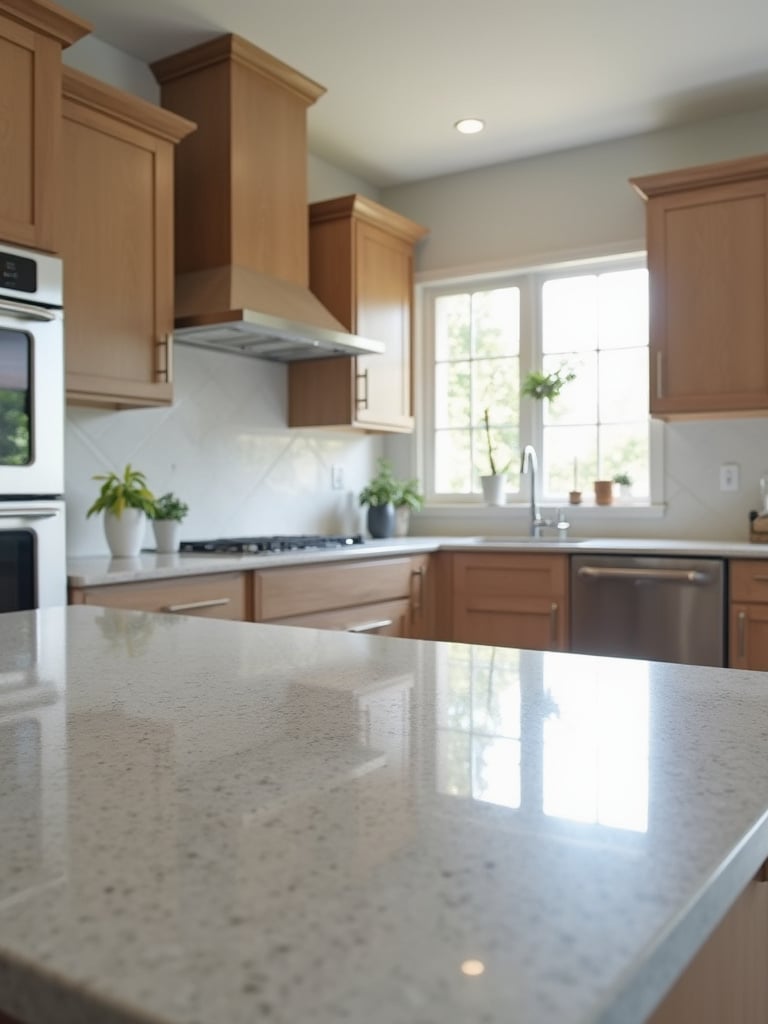
The specific shade of your brown cabinets guides countertop selection in important ways. Light honey or beige cabinets harmonize beautifully with cooler countertops like soft gray quartz or white marble with gray veining. Medium brown cabinets offer remarkable flexibility, pairing well with everything from cream-colored granite to warm butcher block. Dark espresso cabinets benefit from high-contrast pairings like bright white quartz or lighter-toned granite to prevent the kitchen from feeling too heavy. Always consider how the undertones interact—warm brown cabinets with warm-toned countertops create harmony, while pairing with cool countertops creates energetic contrast.
- Samples are essential—view potential countertops against your cabinet color in your actual kitchen lighting
- Consider how the countertop material complements your lifestyle (marble requires more maintenance than quartz)
- Think about edge profiles—simple edges work well with contemporary cabinets while more elaborate profiles complement traditional styles
For those hesitant about bold patterns, remember that the countertop-cabinet relationship sets the foundation for your kitchen’s personality, guiding all other design decisions from backsplash to accessories.
6. Finding the Perfect Backsplash for Your Brown Kitchen
If you’ve struggled with similar rooms before, you’ll appreciate how the right backsplash transforms a brown kitchen from ordinary to extraordinary. This vertical surface serves as both practical protection and visual punctuation, connecting countertops to cabinets while adding personality. Brown cabinets provide a neutral foundation that accommodates virtually any backsplash color or material. Lighter backsplashes in cream, white, or soft blue create airiness and contrast. Deeper tones like navy, forest green, or even burgundy create rich, enveloping warmth. Metallics add unexpected glamour, while natural stone brings organic texture.

Material selection significantly impacts both aesthetics and practicality. Ceramic and porcelain tiles remain favorites for their durability, endless design options, and easy maintenance. Glass tile delivers reflective qualities that brighten spaces with darker brown cabinets. Natural stone like marble or travertine adds luxurious texture but requires periodic sealing. For contemporary kitchens, large-format porcelain slabs minimize grout lines for a cleaner look. Industrial-inspired spaces benefit from stainless steel backsplashes that resist heat and stains while adding urban sophistication.
“The backsplash is your kitchen’s jewelry—it should complement the cabinets without competing for attention.” — Kitchen design axiom
The designer’s secret here is to consider how the backsplash, countertop, and brown cabinets work together as a cohesive system rather than selecting each element in isolation.
7. Selecting Wall Colors to Enhance Brown Cabinetry
When clients ask us about balancing style with comfort, wall color often emerges as the critical factor that can make or break a brown kitchen design. The right wall color creates harmony and enhances the beauty of brown kitchen cabinets, while the wrong choice can make the space feel disjointed or dark. Brown’s earth-tone foundation makes it remarkably adaptable, but success depends on identifying your cabinets’ undertones. Warm browns with red or yellow undertones pair beautifully with creams, soft yellows, gentle corals, or muted oranges. Cooler browns with gray undertones harmonize with soft blues, greens, lavenders, or crisp whites.
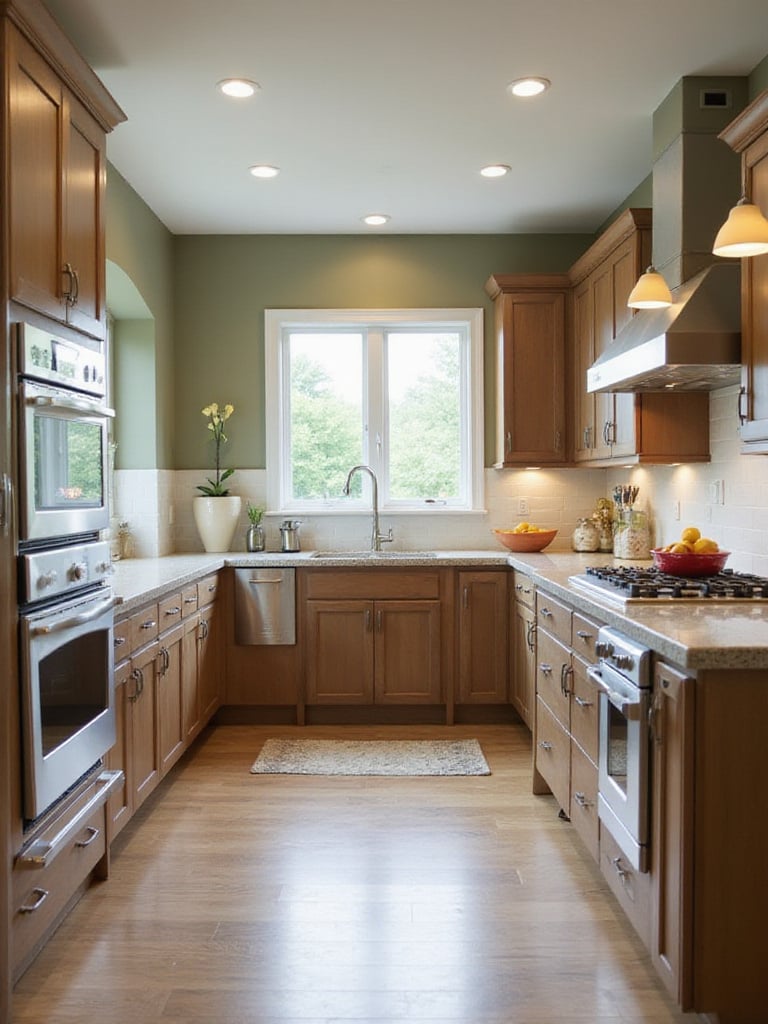
In smaller kitchens with brown cabinets, wall color becomes even more crucial for creating a sense of spaciousness. Light, airy colors like off-white, pale gray, soft blue, or gentle sage green reflect light and visually expand the space. These lighter tones provide breathing room around darker brown cabinets, preventing the kitchen from feeling cramped or cave-like. A monochromatic approach using a lighter shade of the same brown family can create a sophisticated, cohesive look that makes the space feel larger while maintaining warmth.
- Test paint samples on multiple walls—colors appear differently depending on light exposure
- Consider the finish—eggshell or satin finishes are practical for kitchens and reflect more light than flat paint
- Remember that colors appear more intense on large surfaces than on small sample cards
The composition comes together when you view these elements as layers of a cohesive design, with hardware selections providing the finishing touches that elevate the entire look.
8. Hardware Harmony: Choosing Knobs & Pulls for Brown Cabinets
The finishing touch that elevates the entire look of brown kitchen cabinets is thoughtfully selected hardware. These small elements function like jewelry, adding personality while enhancing functionality. The metal finish you choose significantly impacts the overall aesthetic. Warm browns with red or yellow undertones are beautifully complemented by brass, copper, bronze, or gold-toned hardware that enhances their natural warmth. Cooler browns with gray undertones pair elegantly with nickel, chrome, stainless steel, or even matte black, which provides crisp definition and contemporary edge.
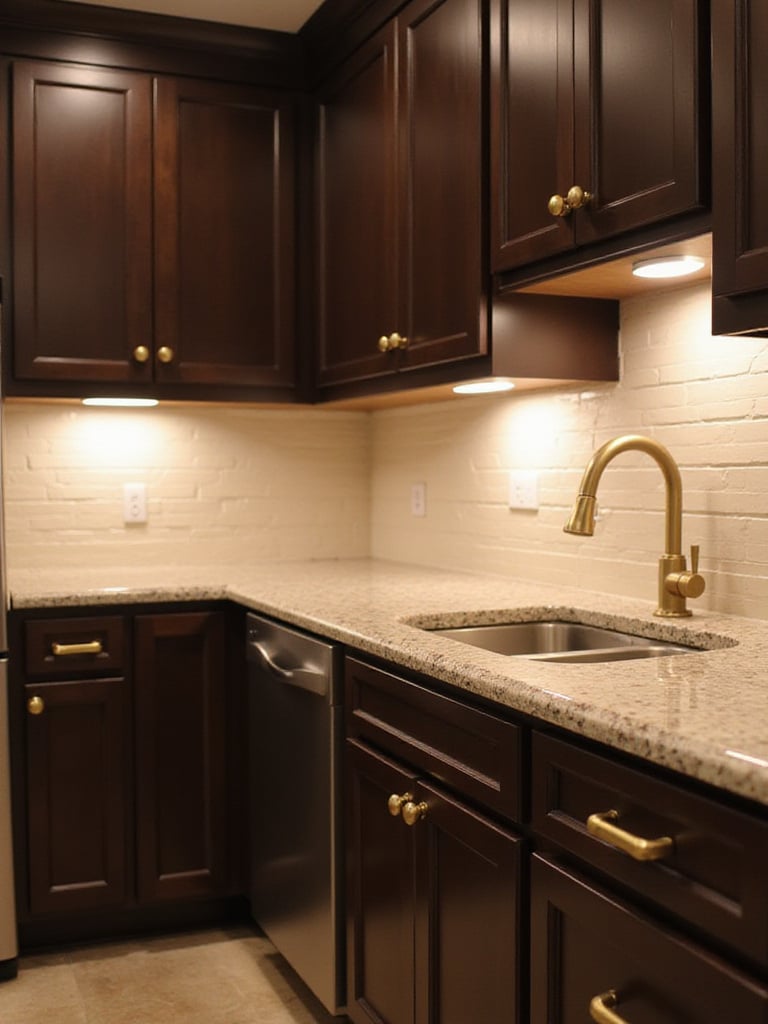
The decision between knobs, pulls, or a combination involves both practical and aesthetic considerations. Pulls offer better grip and leverage, making them ideal for frequently used drawers and larger cabinet doors. Knobs typically cost less and add a classic touch, working well on upper cabinets and smaller doors. Many designers recommend a mixed approach—pulls on drawers and lower cabinets for ease of use, with knobs on upper cabinets for visual balance and budget efficiency. Consider scale carefully; substantial brown cabinets often require larger hardware to maintain proportion, while delicate hardware can look lost on larger cabinet fronts.
“Hardware is the punctuation in your kitchen’s design sentence—it can whisper or shout, but it should always be intentional.” — Hardware design principle
The emotional response this evokes begins with the tactile experience of interacting with your kitchen daily, where these hardware choices become the literal touchpoints of your relationship with the space.
9. Creating a Cozy Haven with Brown Kitchen Cabinets
The ambiance evolves throughout the day as natural light plays across the warm surfaces of brown kitchen cabinets, creating an inherently cozy atmosphere that’s difficult to achieve with cooler cabinet colors. Brown’s psychological associations with earth, wood, and stability evoke feelings of security and comfort—exactly what we want in the heart of our homes. Unlike stark white or cool gray kitchens that can sometimes feel clinical, brown cabinets naturally soften the space, creating a sense of welcome that encourages lingering conversations and unhurried meals.
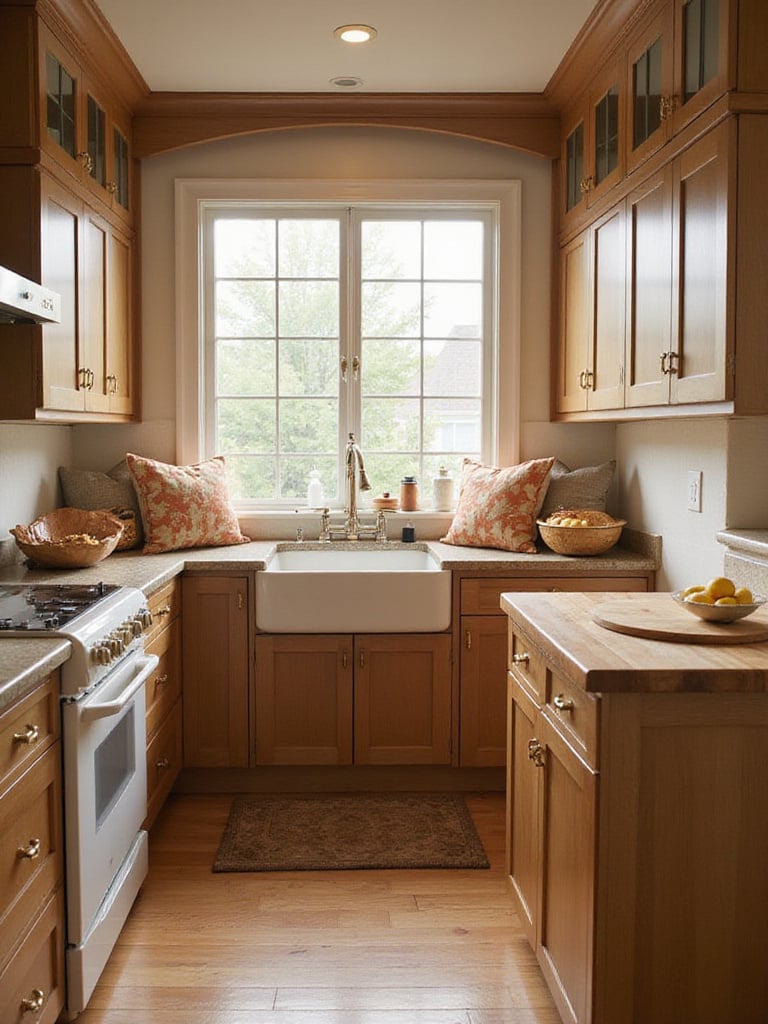
Enhancing this natural coziness requires thoughtful layering of complementary elements. Incorporate varied textures through woven baskets, textured glass, natural stone, or fabric window treatments that add dimensional interest. Lighting plays a crucial role—under-cabinet lights, pendants with warm-toned bulbs, and even table lamps on counters create an inviting glow. Natural elements like potted herbs, wooden cutting boards, or stone accessories reinforce the organic quality of brown cabinets. Consider open shelving to display cherished items that tell your story, and select hardware in warm metals like brass or copper to complement the cabinets’ inherent warmth.
- Incorporate textiles through window treatments, cushions, or even a small rug to soften the space
- Layer different light sources at varying heights to create depth and eliminate harsh shadows
- Add living elements like plants or fresh flowers to bring vitality to the warm foundation
Many homeowners wonder how to balance coziness with timeless appeal, which leads us to explore how brown cabinets serve as the foundation for classic kitchen designs that endure beyond trends.
10. Brown Cabinets: The Foundation of Classic Kitchen Style
The heritage technique gets a contemporary update through brown cabinets that honor traditional design while accommodating modern lifestyles. Brown kitchen cabinets have earned their place as a cornerstone of classic design through their natural connection to wood, which has been the primary material for kitchen cabinetry throughout history. This connection to tradition provides a sense of permanence and stability that more trendy colors simply cannot match. The inherent versatility of brown means it pairs beautifully with traditional elements like natural stone, classic moldings, and timeless patterns while still allowing for contemporary touches that keep the kitchen feeling current rather than dated.

Classic kitchens featuring brown cabinets typically incorporate several defining characteristics. Cabinet doors often feature raised panels, beadboard, or Shaker-style frames that add dimensional interest without being overly ornate. Symmetry and balance guide the layout, creating a sense of order and intention. Natural materials predominate, with stone countertops, ceramic tile, and wood accents creating a harmonious palette. Lighting tends to be warm and layered, often featuring pendant lights over islands and undercabinet lighting that highlights the rich cabinet tones. The overall effect is one of timeless elegance that feels both sophisticated and welcoming—a kitchen that could have existed a century ago yet meets all contemporary needs.
“Classic design isn’t about recreating the past; it’s about honoring timeless principles of proportion, quality, and harmony in ways that serve present needs.” — Design philosophy
The unexpected pairing that always works is combining these classic brown cabinet foundations with carefully selected modern elements, creating kitchens that feel both grounded and fresh.
11. Achieving a Modern Look with Brown Cabinetry
Beyond the obvious placement, consider using brown cabinets for a thoroughly modern kitchen that defies expectations. While brown is often associated with traditional design, it can be stunningly contemporary when approached with intention. The key lies in selecting the right shade and finish—cooler browns with gray undertones like taupe, greige, or deep espresso read as modern, especially in flat-panel or slab door styles that emphasize clean lines. These sophisticated browns create warmth without the heaviness sometimes associated with traditional brown kitchens.
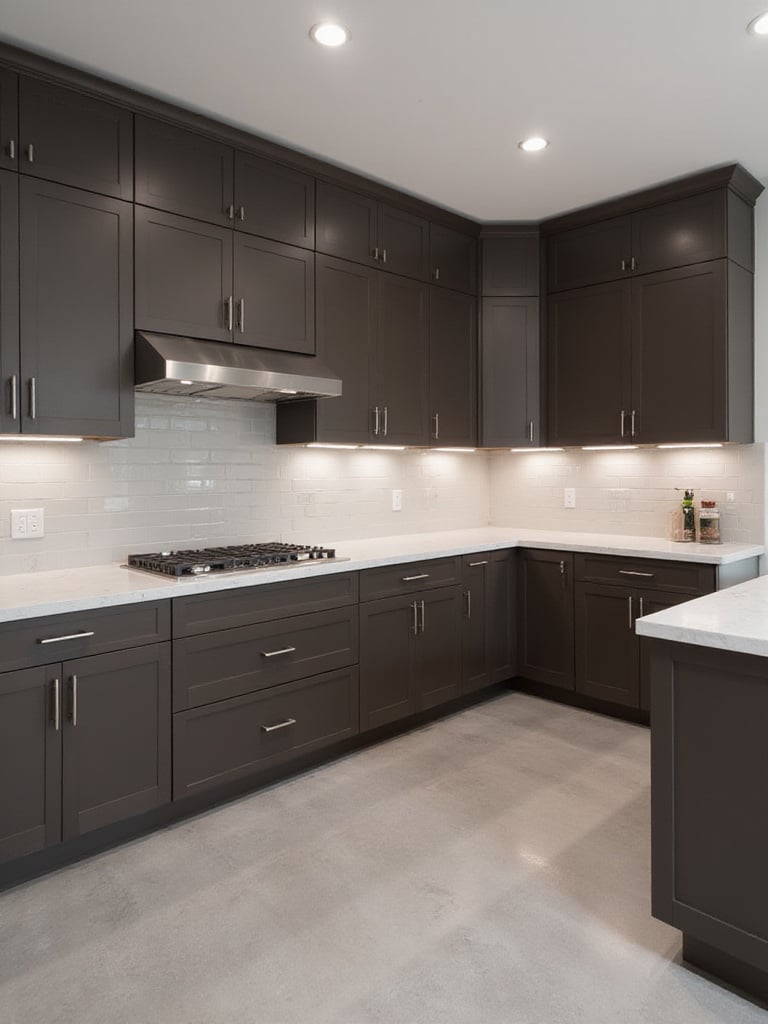
Creating a modern aesthetic with brown cabinets relies on several key design strategies. Prioritize simplicity with minimal hardware or touch-latch mechanisms that maintain clean lines. Incorporate contrasting materials like glass, concrete, or metal to create visual tension that feels deliberately contemporary. Choose countertops with minimal patterning in either high contrast (white) or tonal (similar brown) for a sleek look. Modern backsplashes might feature large-format tiles, solid glass, or continuous materials with minimal grout lines. Lighting should be architectural rather than decorative, with recessed fixtures, linear LEDs, or minimalist pendants. The result is a kitchen that feels warm and inviting without a hint of dated design—modern in approach but with the timeless appeal that makes brown a smart investment.
- Choose hardware with clean lines and minimal ornamentation—or eliminate visible hardware entirely
- Incorporate reflective surfaces like glass backsplashes or stainless steel appliances to create contrast
- Consider mixing brown with black or charcoal for a particularly sophisticated contemporary palette
The material sourcing makes all the difference in how these modern brown kitchens feel, but the same color family can also create beautifully rustic spaces with a completely different character.
12. Embracing Rustic Vibes with Brown Wood Cabinets
The artisan collective that creates these pieces understands that brown wood cabinets are the perfect foundation for rustic kitchen designs that celebrate natural beauty and craftsmanship. Rustic kitchens embrace the inherent character of materials rather than hiding them, making brown wood cabinets with visible grain, knots, and natural variations the ideal choice. This style creates spaces that feel authentic, lived-in, and connected to traditional craftsmanship—a welcome antidote to the sometimes sterile perfection of contemporary design. The warmth of brown cabinets anchors these spaces, creating a sense of permanence and comfort.
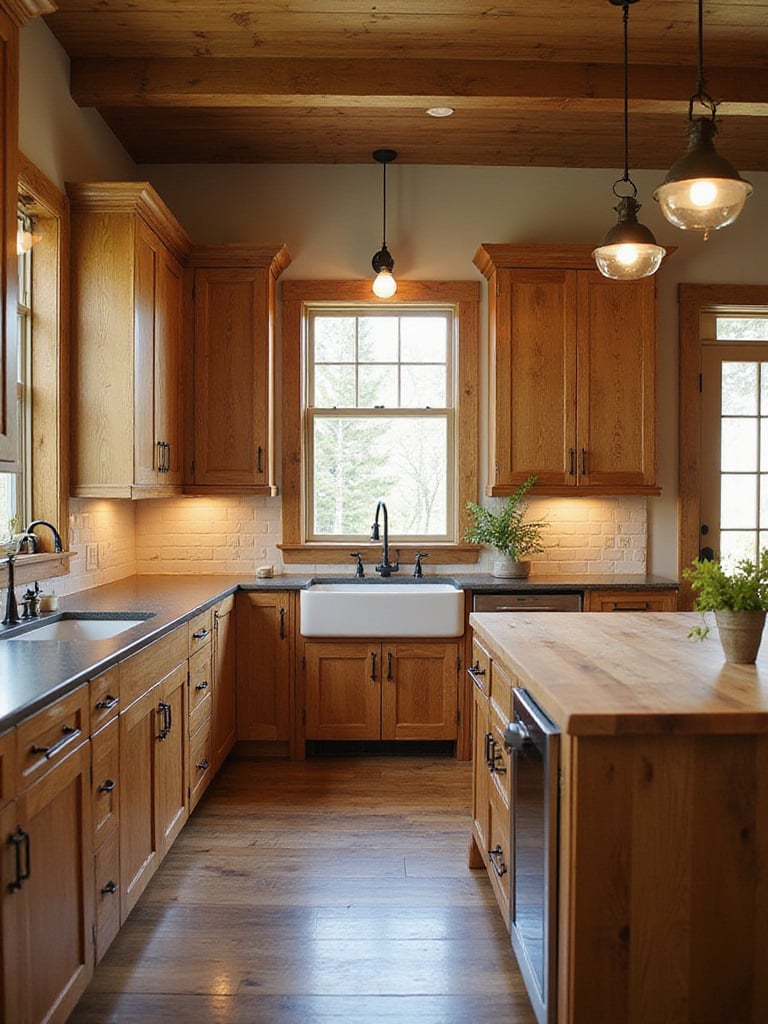
When designing a rustic kitchen around brown cabinets, certain elements enhance the aesthetic beautifully. Opt for warmer brown tones with amber, red, or honey undertones rather than cooler grays or taupes. Cabinet styles with simple frame-and-panel construction, beadboard details, or even reclaimed wood fronts reinforce the rustic character. Complement these cabinets with countertops in natural materials like butcher block, soapstone, or honed granite that develop patina over time. Hardware in oil-rubbed bronze, antique brass, or black iron adds authentic character. Open shelving displaying everyday items, farmhouse sinks, and vintage-inspired lighting complete the look, creating a kitchen that feels like it has evolved naturally over time rather than being created all at once.
“Rustic design isn’t about perfection—it’s about celebrating the beautiful imperfections that make spaces feel authentic and lived-in.” — Rustic design principle
While designed for the living room, we’ve seen creative uses of these rustic brown cabinet approaches in unexpected spaces like home offices, mudrooms, and even bathrooms that benefit from their warmth and character.
13. Built to Last: The Durability of Brown Kitchen Cabinets
The construction technique that ensures longevity is just one reason brown kitchen cabinets represent such a sound investment. Their durability stems from multiple factors working together. Quality materials form the foundation—solid hardwoods like oak, maple, cherry, and walnut naturally resist daily wear and have proven their longevity over generations. Even well-constructed plywood cabinets with real wood veneer fronts can provide excellent durability when properly finished. Construction methods matter significantly; dovetailed drawers, mortise-and-tenon joinery, and full-extension drawer glides with soft-close mechanisms ensure cabinets function flawlessly for decades. These quality components may cost more initially but provide superior value over time.
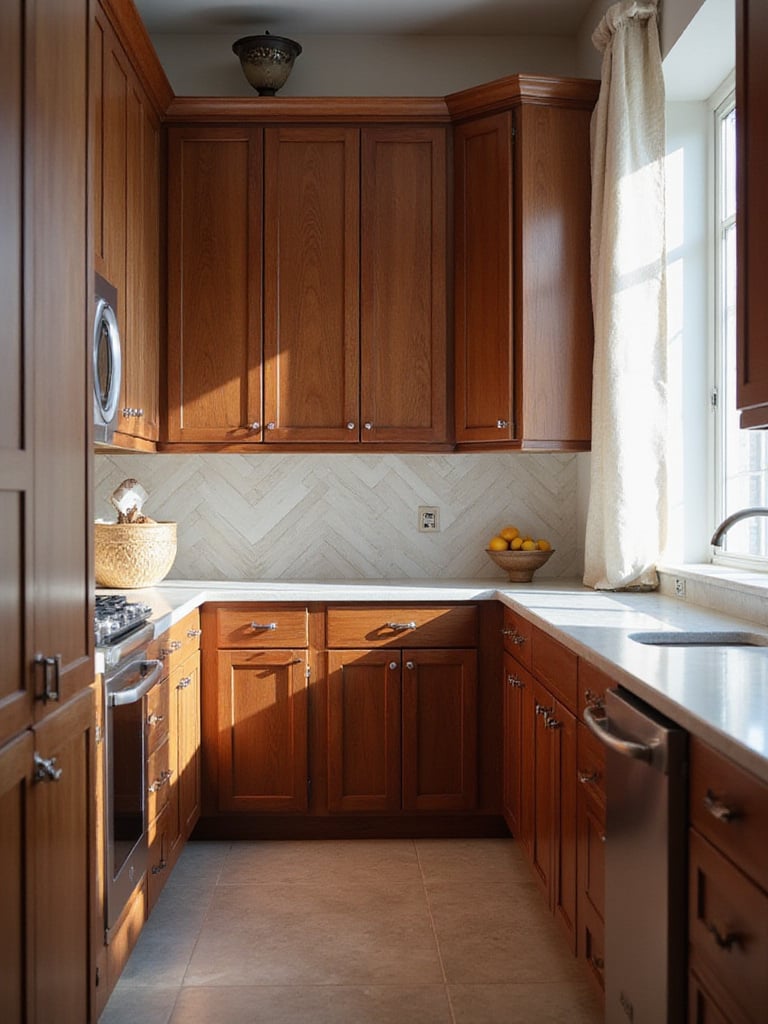
The finish applied to brown cabinets plays a crucial role in their longevity and appearance. High-quality catalyzed conversion varnishes or durable lacquers create a protective barrier against moisture, food stains, UV damage, and general wear. These superior finishes resist chipping and peeling better than less durable alternatives. Brown finishes offer a practical advantage over lighter colors by better hiding minor scratches, scuffs, and the inevitable signs of a well-used kitchen. Even the stain formulation matters, with some offering superior fade resistance to maintain that rich brown color for years. This combination of quality materials, construction, and finishes explains why well-made brown cabinets often become family heirlooms, serving multiple generations.
- Look for solid wood or furniture-grade plywood construction for maximum durability
- Check drawer construction—dovetail joints and solid wood drawer boxes indicate quality
- Examine the finish by looking inside an unfinished area—quality cabinets are finished even in unseen areas
The quality becomes evident after years of use when properly maintained brown cabinets continue to look beautiful while lesser cabinets show their age—which brings us to essential care practices.
14. Keeping Them Beautiful: Care & Maintenance for Brown Cabinets
For those worried about maintenance, brown kitchen cabinets offer practical advantages while still requiring regular care to maintain their beauty. The most common threats include moisture damage from leaks or excessive humidity, grease buildup from cooking, food and beverage spills (especially acidic substances), and damage from harsh or abrasive cleaners. Brown cabinets have a natural advantage over lighter colors in hiding minor smudges and fingerprints, but establishing consistent cleaning routines prevents buildup that can damage the finish over time.
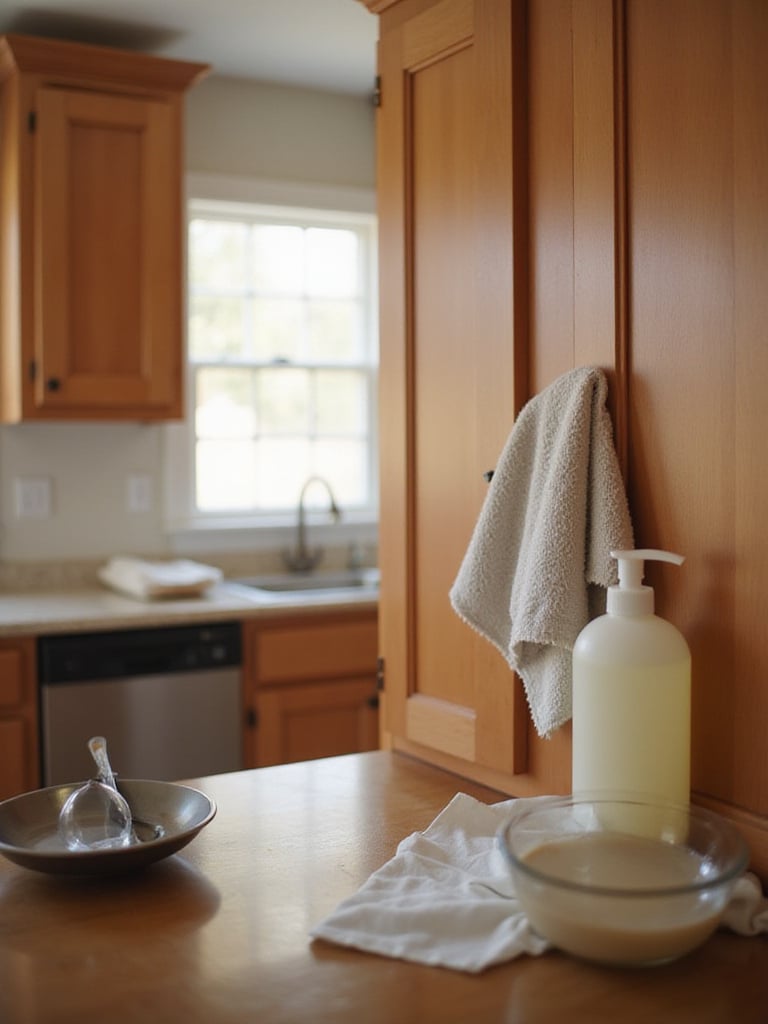
Maintaining brown cabinets requires simple but regular attention. For daily cleaning, a soft cloth dampened with warm water is usually sufficient for removing dust and light soil. For deeper cleaning, a mild solution of dish soap and warm water works well for most finishes—avoid ammonia, bleach, or abrasive cleaners that can damage the surface. Always test any new cleaning product in an inconspicuous area first. Wipe up spills promptly, especially around the sink and stove areas. Consider applying a high-quality cabinet wax or polish recommended for your specific finish once or twice yearly to maintain the protective surface and enhance the natural beauty of the wood or finish.
“The most effective maintenance program is consistent attention rather than occasional deep cleaning—frequent light cleaning prevents issues that become difficult to remedy later.” — Cabinetry care principle
The environmental story behind this piece began with selecting materials and finishes designed for longevity—the most sustainable approach is creating cabinets that don’t need replacement for decades.
15. Are Brown Kitchen Cabinets a Timeless Investment?
The revival of this classic form comes with a twist as designers and homeowners recognize the enduring appeal of brown kitchen cabinets. Their timelessness stems from several key factors. Brown is fundamentally connected to nature, evoking the warmth and stability of wood—qualities that remain desirable regardless of passing trends. This natural association creates an inherent comfort that transcends fashion. Additionally, brown provides remarkable versatility as a backdrop for other design elements, allowing for easy updates to countertops, backsplashes, hardware, or wall colors without replacing the cabinets themselves. This adaptability means brown cabinets can evolve with changing tastes while maintaining their core appeal.
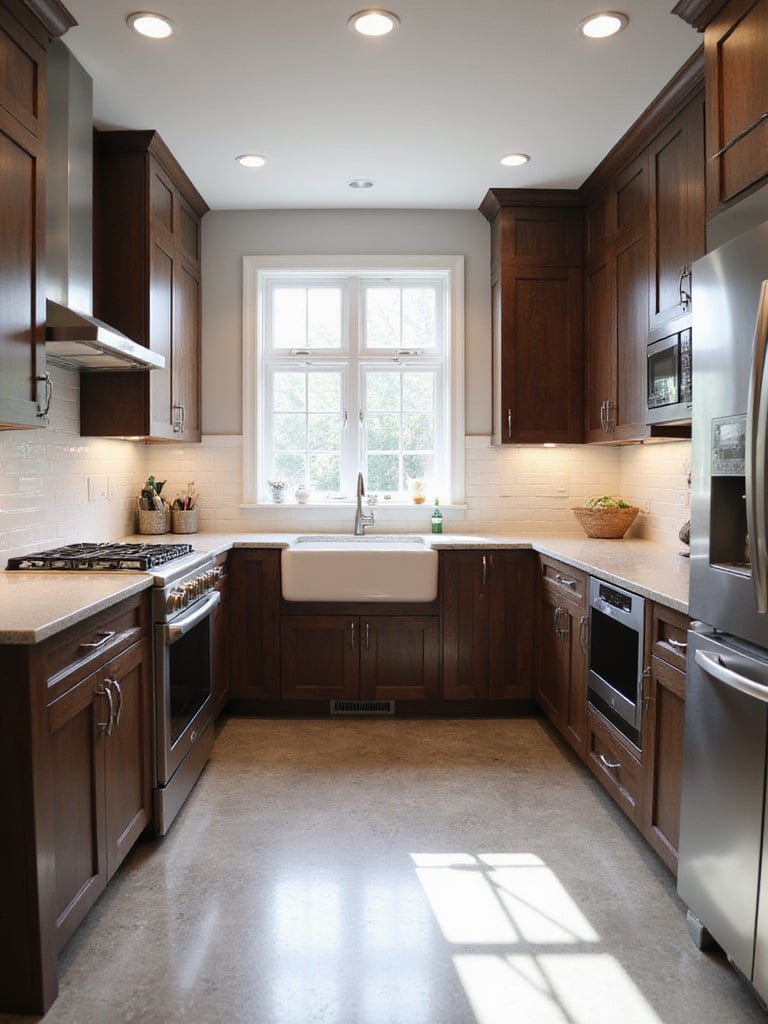
Several considerations can help ensure your brown cabinets remain a truly timeless investment. First, choose classic cabinet door styles like Shaker, recessed panel, or simple flat-panel designs that won’t quickly date. Select a brown shade in the middle range—neither extremely dark nor extremely light—as these tend to have the most staying power. Avoid browns with very strong undertones (like orange-browns) that might feel dated more quickly. Invest in the highest quality construction your budget allows, as well-made cabinets can be refinished rather than replaced if you eventually want a different look. Finally, consider the overall context of your home’s architecture—brown cabinets that complement the home’s inherent style will always feel more appropriate than those that clash with the architectural character.
- Mid-tone browns tend to have the greatest longevity in terms of style
- Quality construction matters more than trendy details for long-term value
- Consider how easily the cabinets could be updated with new hardware or countertops in the future
As morning light filters through, the texture of brown cabinets creates subtle shadows and highlights that change throughout the day—but only with proper lighting that showcases their beauty.
16. Lighting Up Your Brown Kitchen: Tips & Tricks
Professional stylists approach this by first understanding that lighting is absolutely critical in kitchens with brown cabinets. Because brown absorbs rather than reflects light, thoughtful illumination prevents the space from feeling dark or heavy. Proper lighting not only ensures the kitchen functions well for tasks like cooking and cleaning but also highlights the rich beauty of the cabinets themselves, showcasing grain patterns, finish details, and the warm character that makes brown so appealing. Without adequate lighting, even the most beautiful brown cabinets can appear flat or gloomy—but with strategic illumination, they become the stunning focal point they deserve to be.
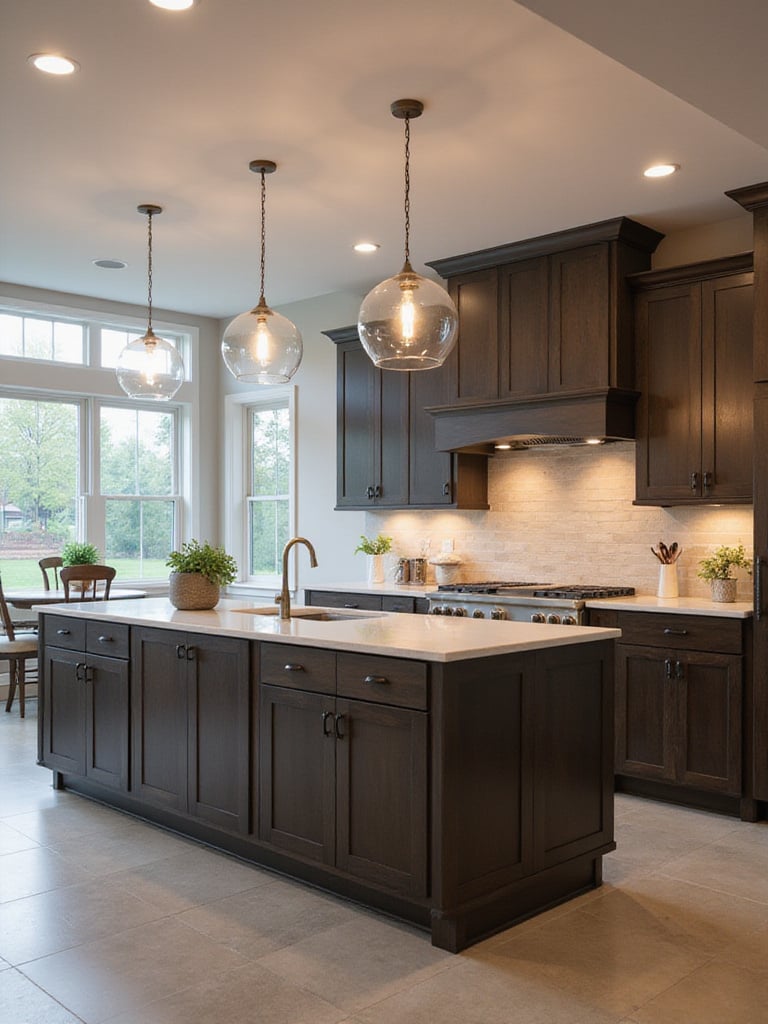
A layered lighting approach creates the most successful environment for brown kitchen cabinets. Begin with ambient lighting that provides overall illumination—recessed ceiling fixtures spaced to eliminate shadows, especially in front of cabinets. Add crucial task lighting focused on work areas; under-cabinet lighting is particularly important with brown cabinets to brighten countertops and make food preparation easier. Pendant lights over islands or dining areas provide both focused light and decorative elements. Finally, consider accent lighting to highlight special features—interior cabinet lighting for glass-front displays or LED strips above cabinets for indirect illumination. For brown cabinets specifically, choose bulbs in the warm to neutral range (2700K-3500K) that enhance the cabinets’ natural warmth rather than cool LEDs that can make them appear flat.
- Install dimmer switches to adjust lighting levels throughout the day and for different activities
- Position recessed lights 12-18 inches away from upper cabinets to minimize shadows
- Consider “daylight harvesting” with skylights or solar tubes to bring natural light into the kitchen
The challenge of awkward spaces becomes easier when proper lighting illuminates brown cabinets effectively, and surprisingly, these beautiful kitchens can be achieved across various budget levels.
17. Brown Cabinets for Every Budget: Options Explored
The maker’s journey from apprentice to master influenced how we approach brown kitchen cabinets at different price points, proving beautiful results are possible regardless of budget. For those with limited funds, several approaches deliver the brown cabinet look without breaking the bank. Refacing existing cabinets with brown veneer or laminate doors preserves the cabinet boxes while completely transforming the appearance. Painting existing cabinets in rich brown tones offers another budget-friendly option. Ready-to-assemble (RTA) cabinets in brown finishes provide significant savings for those willing to handle assembly. For the handy homeowner, building simple cabinet boxes and purchasing pre-made brown doors creates custom looks at lower costs.
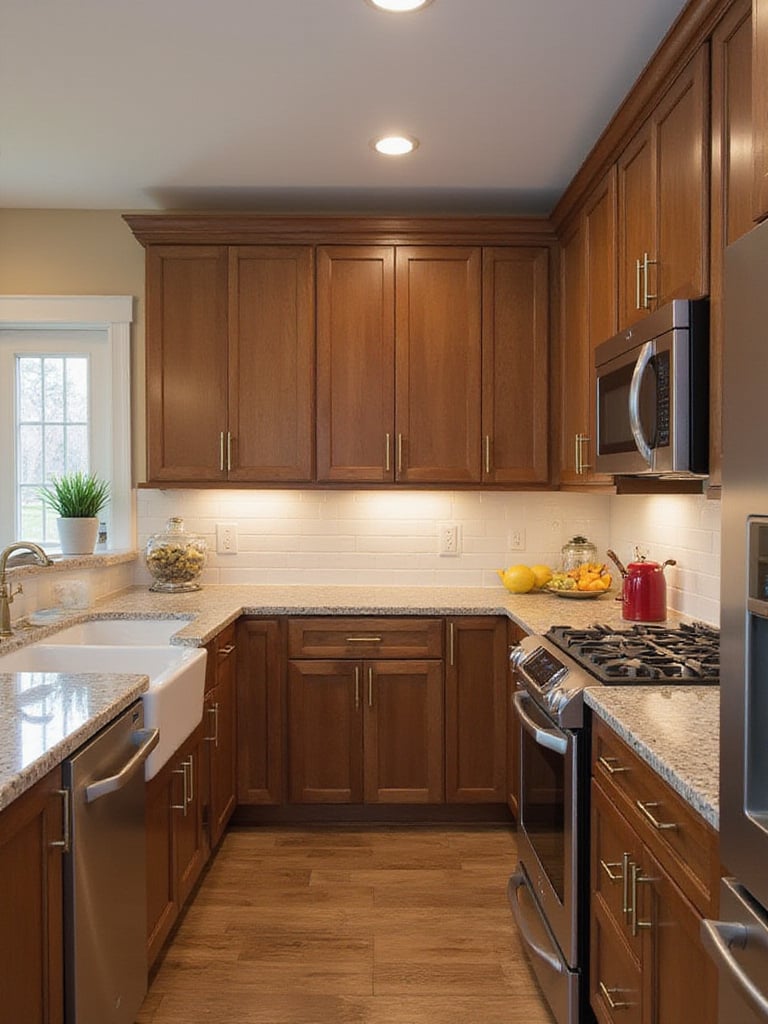
The materials used directly correlate with price point but all can achieve beautiful brown kitchens with proper design. Budget-friendly options include laminate or thermofoil with printed wood grain patterns, MDF with brown paint, or basic wood veneer over particleboard. Mid-range options feature solid wood doors with plywood cabinet boxes, higher-quality veneers, or medium-density hardwoods like birch or maple with brown stains. Premium brown cabinets showcase solid hardwoods like cherry, walnut, or quarter-sawn oak, often with hand-applied finishes that highlight the natural beauty of the wood. Custom details like specialized storage, decorative moldings, and furniture-quality construction techniques distinguish higher-end brown cabinets but aren’t necessary for creating a beautiful, functional kitchen.
“Good design doesn’t have to be expensive, but it always requires thoughtful choices about where to invest and where to compromise.” — Budget design principle
The designer’s attention to detail shows in how even budget-friendly brown cabinets can create stunning kitchens when paired with the right complementary elements.
18. Bringing Your Dream Brown Kitchen to Life: Design Tips
If you’ve struggled with similar rooms before, these practical strategies will help you avoid common pitfalls when designing with brown kitchen cabinets. One frequent mistake is using too much brown without contrast, creating a heavy, monotonous effect. Balance brown cabinets with lighter countertops, backsplashes, or flooring to prevent this. Another error is neglecting proper lighting; brown absorbs light, so layered illumination is essential. Forgetting to incorporate texture can make brown kitchens feel flat—introduce varied textures through countertops, backsplashes, or accessories. Choosing the wrong shade based on undertones leads to clashes with other elements; ensure your brown cabinets’ undertones (warm or cool) complement your overall color palette. Finally, overlooking the importance of hardware can leave the kitchen feeling unfinished; select knobs and pulls that enhance the style and provide proper proportion.
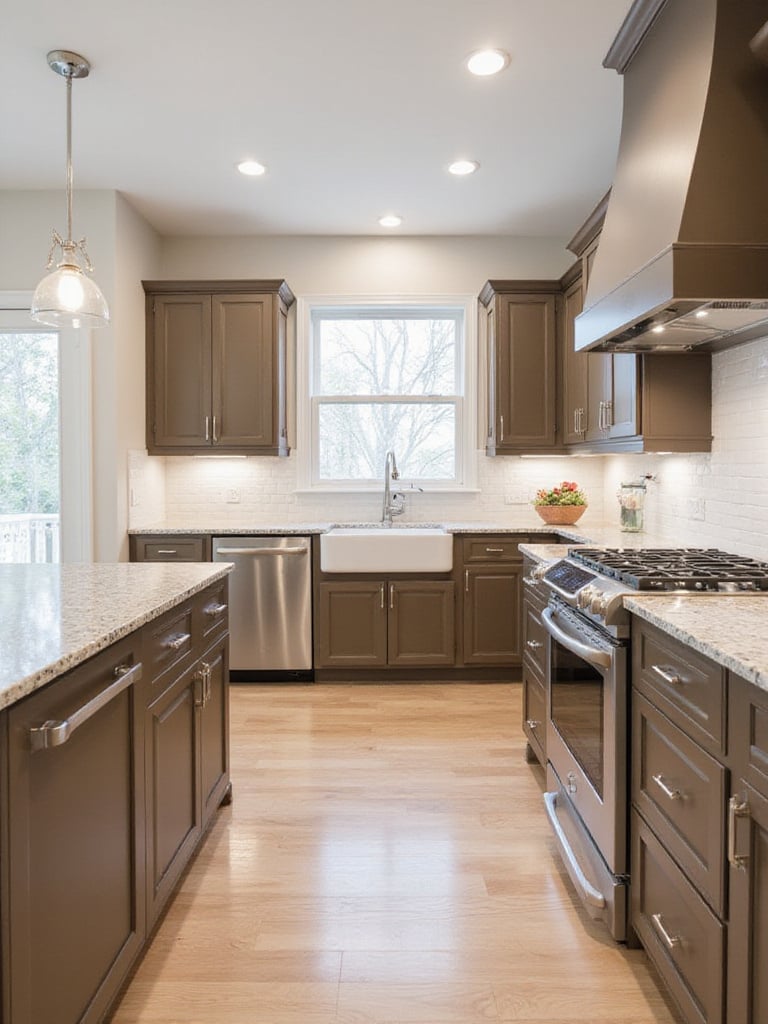
Personalizing your brown kitchen transforms it from generic to genuinely yours. Hardware offers an easy customization opportunity—select pieces that reflect your style, from sleek modern pulls to vintage-inspired knobs. The backsplash provides another canvas for personal expression through color, pattern, or unique materials. Display meaningful items on open shelving or countertops to add character and tell your story. Consider statement lighting fixtures that serve as functional art. Incorporate your favorite colors through accessories, textiles, or even appliances. An island with a distinctive countertop material or color creates a focal point, while unique organizational features tailored to your specific needs make the kitchen truly functional for your lifestyle.
- Take photos of your existing space and use digital tools to visualize different brown cabinet options
- Collect inspiration images but focus on what you love about them rather than trying to recreate them exactly
- Consider how your kitchen will age—choose elements that will continue to please you for years
The journey of this design reflects broader cultural shifts toward spaces that balance beauty with comfort, creating kitchens that are both visually appealing and emotionally satisfying.
Conclusion
Brown kitchen cabinets offer a remarkable foundation for creating spaces that feel both timeless and personally meaningful. From the sophisticated depth of espresso to the golden warmth of honey oak, the spectrum of brown provides flexibility to complement virtually any design style and personal preference. When thoughtfully paired with complementary countertops, backsplashes, and hardware, these cabinets create kitchens that radiate warmth while standing the test of time.
The enduring appeal of brown cabinets lies in their connection to nature and their psychological comfort—they ground the space in something authentic and familiar. Whether you’re working with a generous budget or seeking cost-effective solutions, brown cabinets offer options that deliver both beauty and practicality. With proper lighting, regular maintenance, and personal touches that reflect your unique style, a brown kitchen becomes more than just a functional space—it becomes the true heart of your home.
As you consider your own kitchen design or renovation, remember that brown cabinets aren’t just a color choice—they’re an investment in creating a space that welcomes, comforts, and adapts as your needs and preferences evolve over time.






